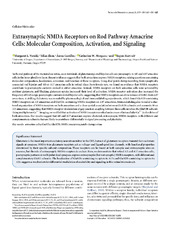| dc.contributor.author | Veruki, Margaret Lin | en_US |
| dc.contributor.author | Zhou, Yifan | en_US |
| dc.contributor.author | Castilho, Aurea | en_US |
| dc.contributor.author | Morgans, Catherine W. | en_US |
| dc.contributor.author | Hartveit, Espen | en_US |
| dc.date.accessioned | 2020-06-18T09:25:54Z | |
| dc.date.available | 2020-06-18T09:25:54Z | |
| dc.date.issued | 2019 | |
| dc.Published | Veruki ML, Zhou Y, Castilho A, Morgans CW, Hartveit E. Extrasynaptic NMDA receptors on rod pathway amacrine cells: molecular composition, activation, and signaling. Journal of Neuroscience. 2019;39(4):627-650 | eng |
| dc.identifier.issn | 1529-2401 | |
| dc.identifier.issn | 0270-6474 | |
| dc.identifier.uri | https://hdl.handle.net/1956/22705 | |
| dc.description.abstract | In the rod pathway of the mammalian retina, axon terminals of glutamatergic rod bipolar cells are presynaptic to AII and A17 amacrine cells in the inner plexiform layer. Recent evidence suggests that both amacrines express NMDA receptors, raising questions concerning molecular composition, localization, activation, and function of these receptors. Using dual patch-clamp recording from synaptically connected rod bipolar and AII or A17 amacrine cells in retinal slices from female rats, we found no evidence that NMDA receptors contribute to postsynaptic currents evoked in either amacrine. Instead, NMDA receptors on both amacrine cells were activated by ambient glutamate, and blocking glutamate uptake increased their level of activation. NMDA receptor activation also increased the frequency of GABAergic postsynaptic currents in rod bipolar cells, suggesting that NMDA receptors can drive release of GABA from A17 amacrines. A striking dichotomy was revealed by pharmacological and immunolabeling experiments, which found GluN2B-containing NMDA receptors on AII amacrines and GluN2A-containing NMDA receptors on A17 amacrines. Immunolabeling also revealed a clustered organization of NMDA receptors on both amacrines and a close spatial association between GluN2B subunits and connexin 36 on AII amacrines, suggesting that NMDA receptor modulation of gap junction coupling between these cells involves the GluN2B subunit. Using multiphoton Ca2+ imaging, we verified that activation of NMDA receptors evoked an increase of intracellular Ca2+ in dendrites of both amacrines. Our results suggest that AII and A17 amacrines express clustered, extrasynaptic NMDA receptors, with different and complementary subunits that are likely to contribute differentially to signal processing and plasticity. | en_US |
| dc.language.iso | eng | eng |
| dc.publisher | Society for Neuroscience | eng |
| dc.rights | Attribution CC BY | eng |
| dc.rights.uri | http://creativecommons.org/licenses/by/4.0 | eng |
| dc.subject | Konfokalmikroskopi / Confocal microscopy | eng |
| dc.subject | Neurovitenskap / nevrovitenskap / Neurosciences | eng |
| dc.subject | Nevrofysiologi / Neurophysiology | eng |
| dc.title | Extrasynaptic NMDA receptors on rod pathway amacrine cells: molecular composition, activation, and signaling | en_US |
| dc.type | Peer reviewed | |
| dc.type | Journal article | |
| dc.date.updated | 2019-11-15T11:27:56Z | |
| dc.description.version | publishedVersion | en_US |
| dc.rights.holder | Copyright 2019 The Author(s) | |
| dc.identifier.doi | https://doi.org/10.1523/jneurosci.2267-18.2018 | |
| dc.identifier.cristin | 1634690 | |
| dc.source.journal | Journal of Neuroscience | |
| dc.relation.project | Norges forskningsråd: 261914 | |
| dc.relation.project | Norges forskningsråd: 214216 | |
| dc.relation.project | Norges forskningsråd: 213776 | |
| dc.relation.project | Norges forskningsråd: 182743 | |
| dc.relation.project | Norges forskningsråd: 189662 | |
| dc.subject.nsi | VDP::Medisinske fag: 700::Basale medisinske, odontologiske og veterinærmedisinske fag: 710 | |
| dc.subject.nsi | VDP::Midical sciences: 700::Basic medical, dental and veterinary sciences: 710 | |

